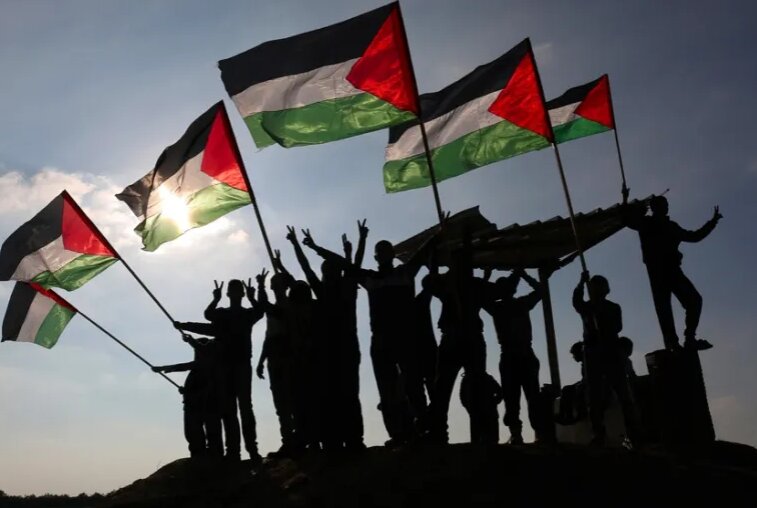London – Despite provocative rhetoric that promotes what is misrepresented as the “cleaning Gaza” and the continuation of the Zionist reconciliation project, Palestinian national unity stands out as a solid fortress against its unbreakable shield and attempts to erase Palestinian identity.
The battle to liberate Palestine is no longer a territorial struggle. It has become an existential test of the will of the people, rejecting surrender, drawing a map of struggle through Palestinian unity and resistance for decades.
Regardless of the outcome of Al-Aqsa’s flood operations, unification is no longer a political option. It is the practical key to existential necessity and liberation.
This popular resistance-based unity that shocked the occupyers and confused their calculations embodies the highest meaning of attribution and heroism.
It links Gaza to Jenin, Jerusalem to Lebanon, West Bank to Baghdad, and Jafa to Sanaa, showing the birth of a consistent axis of resistance that currently holds the initiative.
This is where the role of the axis of resistance becomes clear. Like years of conflict, they have established a true deterrent balance that redefines the rules of community engagement.
Zionist Project: Between Delusion and Internal Destruction
From its founding, the Zionist Project was founded on the basis of grand lies. “A land without people for landless people.” But this mythical story is crumbling under demographic, political and earthly realities.
The internal legitimacy crisis that bothers what is called “Israel” is reflected in deep political and social divisions. Five elections over three years, protests on the streets of Jaffa (trying to rename Tel Aviv against the government), Ethiopian Jews signs racism, crisis of military establishment, crisis of trust between political leadership, and intelligence. Experience unprecedented internal tremor.
The repeated attacks on Gaza, military surprises in Al-Aqsa’s flood operations, and the painful blows suffered by the occupying government during the security violations of the West Bank and Jerusalem, revealed that the so-called “invincible forces” are now a myth of the past. Despair is creeping up to the younger generation.
According to a survey published by Haaretz, 48% of young people aged 18 to 30 are seriously considering moving.
Applications for migration to Canada, Australia and Germany have increased by 37% in the past three months alone.
Even the former immigration minister, even Pinchas Goldstein, described the situation as a “point of return,” saying the entity has witnessed the largest inverse-moving wave since the second intifada.
Amidst the increasing escalation of the Palestinian international recognition and boycotts, sales and sanctions (BDS) campaigns, diplomatic isolation of entities also deepened during the day, causing economic and moral damage to the strategic Israeli sector.
From fragmentation to liberation strategies
Emancipation from the profession is not achieved through emotion alone. Based on a comprehensive reconciliation between Palestinian factions, a unified national vision is needed, and it is necessary to put an end to the divisions that have undermined Palestine’s interior for many years.
It’s time to inspire the PLO system, unify political discourse, and launch a clear project of liberation from rivers to seas.
General resistance, as seen in previous return marches, and proves its effectiveness with an increasing call to revive the Land Day and mark the anniversary of Nakba with wider participation in the return march. These marches show that the masses can create global momentum that occupation cannot be ignored.
At the same time, the growing role of the axis of resistance formed the real umbrella of deterrence despite all the blows it received. Combining Hezbollah’s expertise, Iranian capabilities and, above all, support from Ansalara, the heroism of the Gaza faction, the alliance made the war a costly option for the occupying people.
In particular, after reports by international organisations described the practice as apartheid, the international boycott campaign, which now extends to major academic and economic institutions, has helped to expose the true face of the occupation. These campaigns are more important than outdoor struggles. They complement and strengthen it.
Liberation Project: From resistance to the nation
The liberation of Palestine from the river to the sea is no longer a distant dream. It is becoming a realistic project with its functionality being developed every day.
By leveraging internal cracks in vulnerable Zionist groups, mobilizing global public support, and building robust regional partnerships with the axis of resistance, liberation is closer than ever.
It is no longer possible to ignore the shifts brought about by the Al-Aqsa flood operation. The operational office within the vocational organization is in chaos, and internal voices are calling for a rethinking of the foundations of the Zionist Project.
History repeats itself, but this time at a faster pace.
The very groups that sowed up chaos in our area are now falling apart from within.
Unity is the path to victory
Yes, unity is not just a slogan raised on special occasions, but the essence of survival and resistance. In the face of the collapse of the “Israel” narrative and the collapse of its structural weakness, Palestinian unity, supported by the axis of resistance, becomes a more powerful strategic weapon than traditional weapons.
Palestine is only freed by a unified national grip on decision-making, allowing for a new rewrite of history.
Palestine is not waiting for anyone’s permission. It awaits the unity of its people, the integration of its resistance, and the following voices:
We are one people, one land, one cause. And our unity is our only path to freedom.

